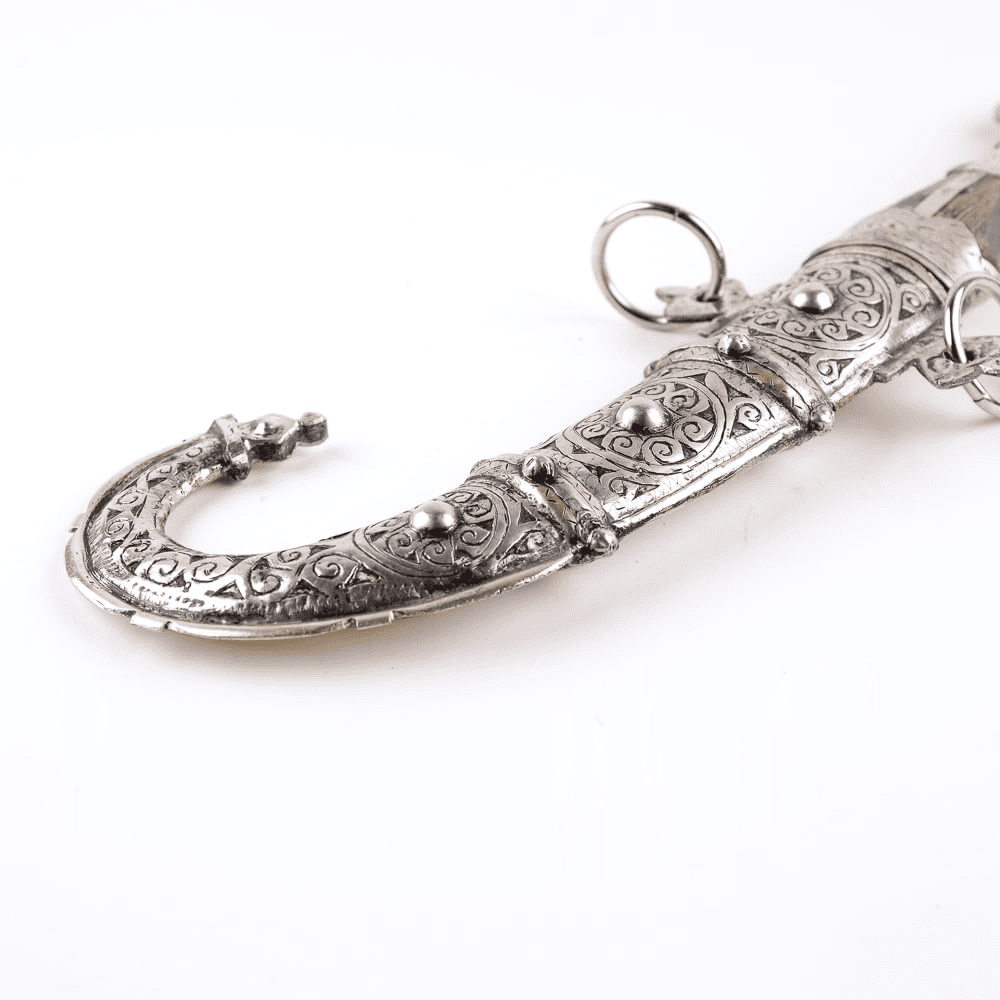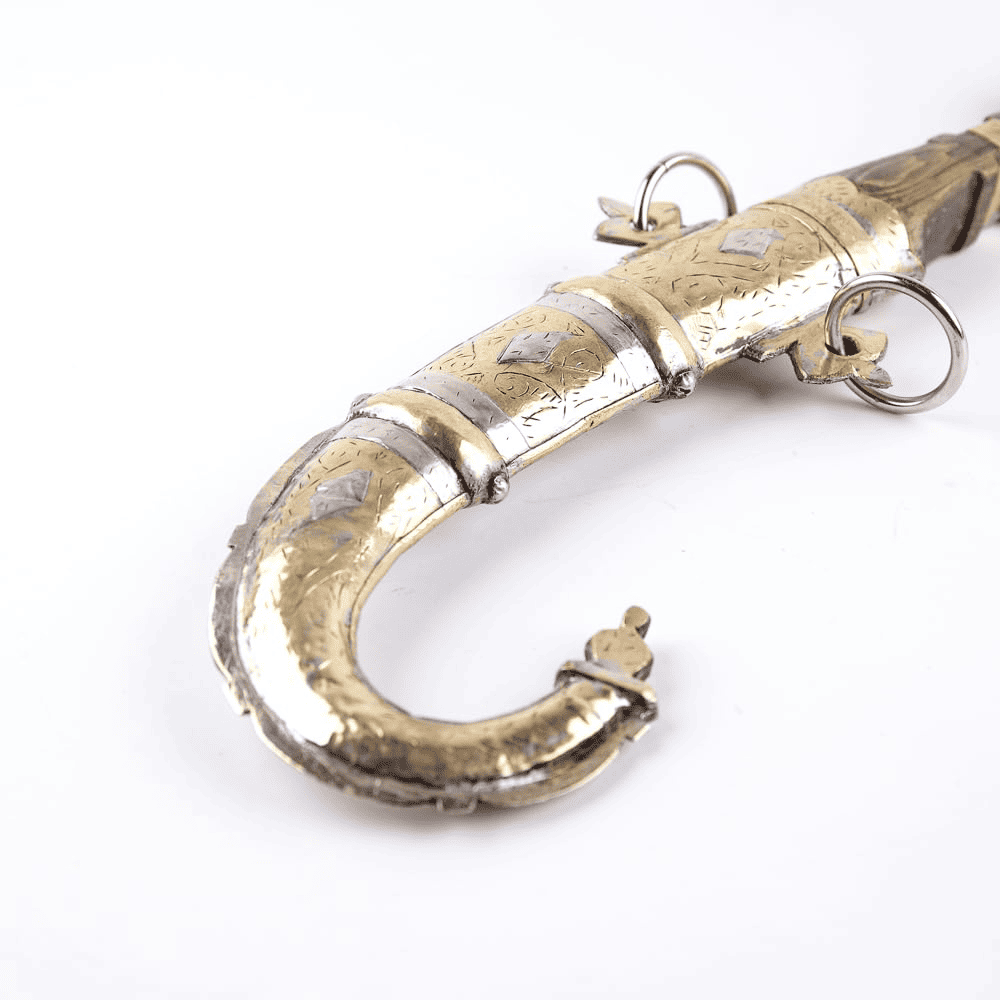What Is a Moroccan Koummya Dagger and Why Is It Unique?
The Moroccan Koummya, or Koumaya, stands as a symbol of heritage, craftsmanship, and tradition among the Berber people of Morocco. This curved dagger is not simply a weapon; it represents elegance, social standing, and a strong sense of cultural identity. Unlike mass-produced decorative blades, the Koummya carries the richness of history and is often worn with pride. Its unique shape, from the curved blade to the intricately designed scabbard, displays a blend of artistry and practicality. These daggers are not generic pieces but bespoke items that have subtle imperfections, reflecting the hands-on, artisanal creation.
- Intricate design emphasizing historical Moroccan craftsmanship.
- Represents tradition and cultural identity.
- Handmade, unique characteristics with variations.
How Does the Handmade Craftsmanship of the Koummya Enhance Its Value?
Each Koummya is crafted by skilled artisans using time-honored techniques passed down through generations. The process involves meticulous attention to detail to ensure every element—from the stainless steel blade to the intricate woodwork of the handle—carries authenticity and charm. Imperfections, rather than detracting from the quality, serve as a testament to its handmade origins. For enthusiasts and collectors, this is a valuable trait that distinguishes it from factory-made reproductions. Handmade daggers hold a personal touch and a story in every curve and line.
- Each dagger is unique due to manual craftsmanship.
- Reflects centuries-old techniques and skills.
- Imperfections signify authenticity, not flaws.
Why Is Stainless Steel Used for the Koummya Blade?
The Koummya features a stainless steel blade, chosen for its durability and resistance to corrosion. While traditionally used as a ceremonial or decorative item, the inclusion of stainless steel ensures that it maintains its beauty over time. The blade’s functionality also remains intact, even if some rust spots appear due to its artisanal nature. This blend of practicality and aesthetic appeal makes the Koummya a desirable addition for collectors or admirers of authentic Moroccan artifacts.
- Durable and corrosion-resistant material.
- Adds functional resilience to a decorative piece.
- Retains traditional design with modern durability.
How Do the Handle and Scabbard Reflect Moroccan Heritage?
The Koummya’s handle and scabbard are typically crafted from wood, further emphasizing its cultural roots. These components often feature intricate carvings, inlays, or designs that echo Moroccan motifs, including geometric patterns and motifs inspired by Berber artistry. These embellishments transform the dagger into more than just a blade; it becomes a work of art that serves as a visual link to Moroccan heritage. Even subtle variations in carving or texture are indicative of the craftsman’s skill and the local traditions that influence each piece.
- Detailed wood carvings showcasing Moroccan motifs.
- Combines form and cultural narrative.
- Subtle variations reflect artisanal effort.
What Should Buyers Expect from a Handmade Koummya?
As a handmade artifact, the Moroccan Koummya may feature imperfections or slight variations in its blade, handle, and scabbard. These quirks are part of the charm of authentic craftsmanship. Rather than being considered defects, they demonstrate the piece’s handmade nature and artisan roots. Buyers should understand and appreciate these nuances, as they contribute to the dagger’s unique identity. The color, texture, and small flaws make every piece one-of-a-kind.
- Variations and imperfections showcase uniqueness.
- Adds character and authenticity.
- Enhances collector’s value due to bespoke features.
What Is the Cultural Significance of the Koummya’s Wear and Display?
The Koummya is traditionally worn with ceremonial attire, such as the djellaba, hanging at the left side by a cordelière tied to the right shoulder. This positioning signifies status, pride, and group identity. Today, owning a Koummya can act as a bridge to Moroccan culture and heritage, often displayed in homes as a symbol of pride and tradition. The dagger offers a blend of historical significance and aesthetic allure, serving as a connection to Moroccan traditions and daily life.
- Often worn as a ceremonial piece.
- Reflects group identity and status.
- Decorative item that conveys cultural pride.
How Does the Moroccan Koummya Compare to Other Jambiyas?
The Koummya is part of a larger family of curved daggers derived from the Arabic Jambiya, each with distinct local variations. While the broader Jambiya family stretches across the Arabian Peninsula, the Koummya stands out for its specific Moroccan features, such as the curved blade and distinct hilt designs. Comparing it to other Jambiyas highlights the regional adaptations in style, material, and symbolic meaning. Each version tells a story unique to its geography and history.
- Represents a localized form of the Jambiya.
- Distinct design elements tied to Morocco.
- Regional adaptations mark cultural variance.
What Are the Display Options for the Koummya?
Whether placed in a display cabinet or mounted on a wall, the Koummya is an attention-grabbing piece due to its distinct silhouette and craftsmanship. For collectors, enthusiasts, or those with an appreciation for cultural artifacts, it is more than a decorative item; it tells a story. Properly displayed, it invites conversation about its origins, cultural role, and craftsmanship. Its unique shape and ornate detailing make it a standout addition to any home or office décor.
- Suitable for decorative display.
- Adds cultural depth to home settings.
- Can serve as a conversation piece.
Why Should Collectors Consider the Koummya as a Valuable Addition?
Collectors of authentic cultural artifacts or handmade items find the Koummya a worthy addition due to its deep historical roots and artistic value. Each piece offers a glimpse into Moroccan traditions and the skill of local craftsmen. Authenticity is key, and the imperfections, minor color variations, and intricate designs make each Koummya distinct. Its appeal extends beyond aesthetics; it encapsulates Moroccan history and craftsmanship, making it a prized collectible.
- Authenticity and craftsmanship appeal to collectors.
- Deep historical significance.
- Offers a unique representation of Moroccan culture.
How Does the Koummya Fit Into a Modern Home Setting?
Despite its historical roots, the Moroccan Koummya fits well within modern interiors, adding a touch of heritage and artistic flair. Its traditional aesthetic blends with contemporary styles, often serving as a focal point in eclectic or culturally themed rooms. Whether placed alongside modern decor or as part of a themed collection, it enhances the space with its unique charm. The Koummya bridges past and present, making it a striking addition to modern décor.
- Complements modern and traditional spaces.
- Acts as a standout decorative piece.
- Bridges cultural heritage and contemporary design.







Reviews
There are no reviews yet.